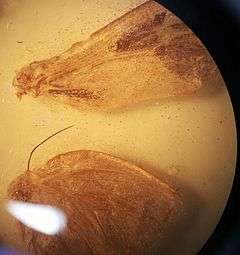Wing coupling

Some four-winged insect orders, such as the Lepidoptera, have developed a wide variety of morphological wing coupling mechanisms in the imago which render these taxa as "functionally dipterous" (effectively two-winged) for efficient insect flight.[1] All, but the most basal forms, exhibit this wing coupling.[2]:4266
The mechanisms are of three different types - jugal, frenulo-retinacular and amplexiform.[3]
Jugal wing coupling
The more primitive groups of moth have an enlarged lobe-like area near the basal posterior margin, i.e. at the base of the forewing, called jugum, that folds under the hindwing in flight.[2][4]:631-664
Frenulo-retinacular wing coupling

Other groups of moth have a frenulum on the hindwing that hooks under a retinaculum on the forewing.[4] The retinaculum is a loop on the underside of the forewing of some moths. Along with the frenulum, a spine at the base of the forward or costal edge of the hindwing, it forms a coupling mechanism for the front and rear wings of the moth.
Amplexiform wing coupling
In the butterflies[lower-alpha 1] and in the Bombycoidea[lower-alpha 2] there is no arrangement of frenulum and retinaculum to couple the wings. Instead, an enlarged humeral area of the hindwing is broadly overlapped by the forewing. Despite the absence of a specific mechanical connection, the wings overlap and operate in phase. The power stroke of the forewing pushes down the hindwing in unison. This type of coupling is a variation of frenate type but where the frenulum and retinaculum are completely lost.[1][5]
Notes
- ↑ The male of one species of hesperiid (skipper) butterfly does have wing couplings.
- ↑ The Sphingidae (hawk moths) however do have wing couplings.
References
- 1 2 Dudley, Robert (2002). The biomechanics of insect flight: form, function, evolution (Reprint, illustrated ed.). Princeton University Press. p. 476. ISBN 978-0-691-09491-5.
- 1 2 Stocks, Ian (2008). "Wing coupling". In Capinera, John L. Encyclopedia of Entomology. Gale virtual reference library 4 (2 ed.). Springer Reference. p. 4345. ISBN 978-1-4020-6242-1. Retrieved 14 November 2010.
- ↑ Scoble, M.J. (1995). The Lepidoptera: form, function and diversity (Reprint (illustrated) ed.). Oxford University Press. p. 416. ISBN 978-0-19-854952-9. Retrieved 14 November 2010. Subsec. "Wing coupling". Pp 56-60.
- 1 2 Powell, Jerry A. (2009). "Lepidoptera". In Resh, Vincent H.; Cardé, Ring T. Encyclopedia of Insects (2 (illustrated) ed.). Academic Press. p. 1132. ISBN 978-0-12-374144-8. Retrieved 14 November 2010.
- ↑ Gorb, Stanislav (2001). "Inter-locking of body parts". Attachment devices of insect cuticle. Springer. p. 305. ISBN 978-0-7923-7153-3. Retrieved 16 November 2010.
Sources
- Pinhey, E (1962). Hawk Moths of Central and Southern Africa. Longmans Southern Africa, Cape Town.